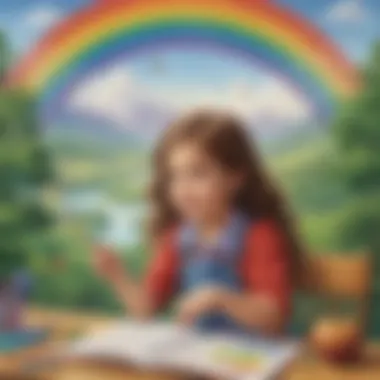Unlocking the Magic of Rainbow Science for Young Learners


Science Fun Facts
Rainbows have fascinated scientists and enthusiasts for centuries. Did you know that the colors in a rainbow appear in a specific order due to the varying wavelengths of light? Red has the longest wavelength, while violet has the shortest. This unique phenomenon showcases the beautiful spectrum of visible light in nature.
Discover the Wonders of Science
In exploring rainbow science, we unlock the secrets of light and color. By delving into various scientific concepts, children can unravel the mysteries behind these vibrant arcs in the sky. Educational videos and animations provide visual aids to enhance understanding, while interactive learning tools engage young learners in a hands-on exploration of the topic.
Science Quiz Time
Engage young minds with interactive quizzes and brain teasers about rainbow science. Test their knowledge through multiple-choice questions that challenge their understanding of colors and light. By incorporating gamification elements, learning becomes an entertaining and enriching experience for kindergarten students.
Science Experiment Showcase
The excitement continues with fun and engaging experiments that bring rainbow science to life. Step-by-step instructions guide children through each activity, detailing the materials needed and safety tips to ensure a secure learning environment. From creating prisms to observing color mixtures, these experiments offer a hands-on approach to understanding the wonders of light and color.
Introduction to Rainbow Science
Rainbow science opens a kaleidoscopic world of wonder and exploration for kindergarten students. Understanding the mysteries of colors and rainbows is not just about visual admiration but delving into the fascinating realm of science. This article journeys through a captivating exploration of colors, aiming to spark curiosity and promote a holistic learning experience for young minds.
Exploring the Phenomenon of Rainbows
The Science Behind Rainbow Formation
In unraveling the enigma of rainbow formation, we dive into the intricate interplay of light and water droplets. The essence lies in the refraction, reflection, and dispersion of light within water droplets, crafting the mesmerizing spectrum of colors we witness. Understanding the science behind rainbow formation equips young learners with foundational knowledge about optics and natural phenomena. It serves as a gateway to comprehend the significance of physics and natural patterns, fostering scientific inquiry and analytical thinking.


Investigating the Role of Light and Water Droplets
Peering into the role of light and water droplets in creating rainbows unveils a blend of physics and meteorology. Light, acting as a spectrum of hues, interacts with water droplets to create the optical phenomenon we perceive. By investigating this dynamic relationship, children develop an appreciation for the harmonious convergence of elements in nature. Exploring how light and water collaborate to paint the sky with rainbows not only cultivates scientific curiosity but also nurtures a sense of wonder and appreciation for the natural world.
Interactive Learning Activities
Interactive learning activities play a pivotal role in the exploration of rainbow science for kindergarten students. By engaging young minds in hands-on experiences and creative endeavors, these activities foster curiosity, critical thinking, and a deeper understanding of scientific concepts. Through interactive learning, children develop essential skills while having fun and directly observing the wonders of rainbow phenomena. This section will detail various activities aimed at captivating young learners and instilling a love for experimentation and discovery.
Rainbow Slime Creation
Materials Needed for Rainbow Slime Experiment
Rainbow slime creation requires specific materials to ensure the success of the colorful experiment. Items such as clear glue, liquid starch, food coloring in various hues, and glitter are essential for achieving that vibrant and captivating rainbow effect. Each material contributes uniquely to the texture, color, and consistency of the slime, allowing children to explore and manipulate different ingredients to create their own sensory masterpiece. Understanding the properties of each material is crucial to the outcome of the experiment, providing a hands-on lesson in chemistry and sensory exploration.
Step-by-Step Guide to Making Rainbow Slime
The step-by-step guide for making rainbow slime offers a detailed roadmap for young scientists to follow. From measuring out ingredients to mixing colors in specific sequences, each step is crucial in achieving the desired rainbow effect. This guide not only facilitates the creation of slime but also teaches children about the significance of following procedures, experimenting with ratios, and observing chemical reactions. Making rainbow slime is an engaging way to introduce children to the world of polymers and non-Newtonian fluids, igniting their curiosity and creativity through a visually exciting and tactile experience.
Colorful Rainbow Art Projects
Exploring Different Art Techniques
Engaging in colorful rainbow art projects opens up a world of creative exploration for kindergarten students. By exploring different art techniques such as watercolor blending, paper marbling, and mixed media collage, children can experiment with colors, textures, and composition to express their vision of a rainbow. Each art technique offers a unique perspective on blending colors, creating gradients, and understanding the visual impact of different artistic methods. Through hands-on art projects, young learners develop fine motor skills, aesthetic appreciation, and an eye for detail that can be applied to future creative endeavors.
Creating a Rainbow-themed Masterpiece
Crafting a rainbow-themed masterpiece allows children to integrate various art techniques into a cohesive and visually stunning creation. From choosing a color palette to planning the composition, each decision contributes to the final artwork's impact and message. By encouraging young artists to think critically about color choices, symbolism, and storytelling through art, this activity fosters creativity, self-expression, and attention to detail. Creating a rainbow-themed masterpiece is not only a fun art project but also a meaningful exploration of color theory, emotional expression, and artistic vision.


Rainbow Science Experiments
DIY Rainbow In a Jar Experiment
The DIY rainbow in a jar experiment is a visually captivating demonstration of density and liquid layers. By using common household items like honey, corn syrup, dish soap, and colored sugar solutions, children can create a miniature rainbow in a clear container. Through this experiment, kids learn about the concept of density, the properties of different liquids, and the scientific principle of stratification. The DIY rainbow in a jar experiment not only showcases the beauty of color layering but also provides a hands-on lesson in chemistry, physics, and experimental methodology.
Rainbow Density Column Exploration
Exploring the rainbow density column introduces children to the fascinating world of liquid stratification and viscosity. By layering liquids of varying densities in a transparent column, young learners can observe how different liquids naturally separate based on their weight and composition. This experiment highlights the principles of density, buoyancy, and liquid interactions in a visually engaging and informative way. Through hands-on exploration of rainbow density columns, children gain insight into scientific concepts and observation skills, setting the foundation for future experimentation and discovery.
Educational Benefits of Rainbow Science
Rainbow science offers a myriad of educational benefits for kindergarten students. By engaging in activities centered around colors and rainbows, children enhance their color recognition skills, cognitive development, and curiosity towards scientific exploration. Understanding the importance of color identification lays a strong foundation for cognitive growth, allowing young minds to grasp complex concepts more effectively. The immersive nature of rainbow science ignites a passion for learning early on, fostering a deep-rooted love for scientific inquiry in children.
Enhancing Color Recognition Skills
Color recognition skills play a crucial role in cognitive development, shaping how children perceive and interpret the world around them. The ability to identify and differentiate colors not only aids in language and math development but also enhances visual processing abilities. Through activities that focus on color identification, such as sorting objects by color or creating colorful artworks, children sharpen their cognitive skills while exploring the rich tapestry of colors present in the environment.
Fostering Curiosity and Exploration
Encouraging inquiry-based learning within the realm of rainbow science sparks curiosity and drives children to ask questions, seek answers, and make connections between concepts. This method of learning places the child at the center of exploration, empowering them to take charge of their knowledge acquisition. By inspiring a love for science through hands-on experiments and creative projects, children develop a lifelong curiosity for the world around them, instilling a deep appreciation for the scientific process and discovery.
Encouraging Inquiry-Based Learning
Inquiry-based learning promotes critical thinking skills and nurtures a sense of wonder in young learners. By encouraging children to explore scientific phenomena through hands-on activities, educators enable them to engage with the material actively, leading to a deeper understanding of the subject matter. This approach not only cultivates a habit of questioning and seeking explanations but also cultivates a growth mindset, fostering a love for learning that transcends the confines of the classroom.


Inspiring a Love for Science
Inspiring a love for science early on plants the seeds for future innovation and discovery. By exposing children to the wonders of the natural world and the scientific principles that govern it, educators instill a sense of curiosity and awe that motivates children to pursue further scientific inquiry. This passion for exploration and discovery forms the basis for future academic pursuits and sets the stage for innovative thinking and problem-solving skills in the years to come.
Promoting STEM Education
The integration of science, technology, engineering, and mathematics (STEM) in rainbow science activities equips children with essential skills needed for success in the 21st century. By immersing students in interdisciplinary learning experiences, educators prepare them for future innovations and challenges, fostering a holistic approach to problem-solving and critical thinking. This integration of STEM principles not only enriches the learning experience but also cultivates a deep appreciation for the interconnectedness of various fields of study, laying a strong foundation for lifelong learning and career readiness.
Integration of Science, Technology, Engineering, and Mathematics
The incorporation of STEM principles into rainbow science experiments and projects offers a comprehensive approach to learning, blending theoretical concepts with practical applications. Through hands-on activities that involve designing, constructing, and testing, children develop a range of skills, including logical reasoning, spatial awareness, and creative problem-solving. This integration fosters a well-rounded understanding of how the different fields of STEM intersect, preparing students for future academic pursuits and real-world challenges.
Preparing Young Minds for Future Innovation
By engaging in rainbow science activities that emphasize innovation and experimentation, children develop the mindset and skills necessary to drive future innovations. Encouraging young minds to explore, question, and create fosters an entrepreneurial spirit and a desire to make meaningful contributions to society. The exposure to STEM education at an early age empowers children to think critically, adapt to new technologies, and collaborate effectively, laying a solid foundation for future success in an ever-evolving world of innovation and discovery.
Parental Involvement and Support
Parental involvement and support play a crucial role in enriching the learning experience of kindergarten students delving into the wonders of rainbow science. Engaging parents in scientific exploration alongside their children not only fosters a deeper connection between families but also enhances the overall educational journey. By actively involving parents in rainbow science activities, children can benefit from shared moments of discovery and creativity, improving bonding and cognitive development.
It is essential for parents to understand the significance of their participation in their child's scientific endeavors, recognizing that their involvement can spark curiosity and foster a love for learning. Encouraging parents to engage in rainbow science activities empowers them to become active participants in their child's education, leading to a more holistic and supportive learning environment. Parents who actively participate in scientific exploration with their children also contribute to promoting a positive attitude towards STEM subjects at an early age, setting a strong foundation for future academic pursuits.
Moreover, involving parents in rainbow science activities allows them to witness firsthand the wonder and excitement that scientific experiments and projects can bring to their child's life. These shared experiences create lasting memories and strengthen the parent-child bond, encouraging open communication and knowledge sharing within the family. Through parental involvement, children not only gain valuable support and encouragement but also access a wealth of knowledge and guidance, nurturing their curiosity and inspiring a lifelong interest in the world of science and discovery.
Engaging Parents in Rainbow Science Activities
Benefits of Family Science Exploration
Exploring the benefits of family science exploration within the context of rainbow science activities unveils a multitude of advantages for both children and parents alike. By engaging in scientific endeavors as a family unit, parents have the opportunity to actively participate in their child's learning process, fostering a sense of collaboration and shared achievement. Family science exploration facilitates meaningful interactions between parents and children, promoting a deeper understanding of scientific concepts and nurturing critical thinking skills in young learners.
One key characteristic of family science exploration is its ability to create a supportive and inclusive learning environment where children feel encouraged to ask questions, experiment freely, and explore the world around them with curiosity and enthusiasm. This collaborative approach to scientific discovery not only boosts confidence and self-esteem in children but also instills a sense of wonder and awe towards the marvels of the natural world.
The unique feature of family science exploration lies in its capacity to transcend traditional education boundaries, providing a hands-on and interactive platform for parents and children to engage in mutual learning and knowledge sharing. Through family science exploration, parents can actively participate in their child's intellectual development, strengthening the parent-child bond and creating a nurturing space for exploration and growth. The advantages of family science exploration in the context of rainbow science activities are manifold, offering families the opportunity to bond, learn, and discover together in a stimulating and supportive setting.







